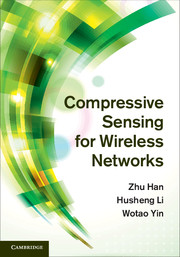5 - CS analog-to-digital converter
from Part I - Compressive Sensing Technique
Published online by Cambridge University Press: 05 June 2013
Summary
An analog-to-digital converter (ADC) is a device that uses sampling to convert a continuous quantity to a discrete-time representation in digital form. The reverse operation is performed by a digital-to-analog converter (DAC). ADC and DAC are the gateways between the analog world and digital domain. Most signal processing tasks are implemented in the digital domain. Therefore, ADC and DAC are the key enablers for the digital signal processing and have significant impacts on the system performances.
In this chapter, we study the literature of CS-based ADCs. We introduce the traditional ADC and its concepts first. Then, we study two major types of CS-ADC architectures, Random Demodulator and Modulated Wideband Converter. Next, we investigate the unified framework, Xampling, and briefly explain the other types of implementation. Finally, we present a summary.
Traditional ADC basics
In this section, we study the basics of ADC by the sampling theorem, quantization rule and practical ADC implementation in the following subsections.
Sampling theorem
In digital processing, it is useful to represent a signal in terms of sample values taken at appropriately spaced intervals as illustrated in Figure 5.1. The signal can be reconstructed from the sampled waveform by passing it through an ideal low-pass filter. In order to ensure a faithful reconstruction, the original signal must be sampled at an appropriate rate, as described in the sampling theorem.
- Type
- Chapter
- Information
- Compressive Sensing for Wireless Networks , pp. 118 - 138Publisher: Cambridge University PressPrint publication year: 2013



